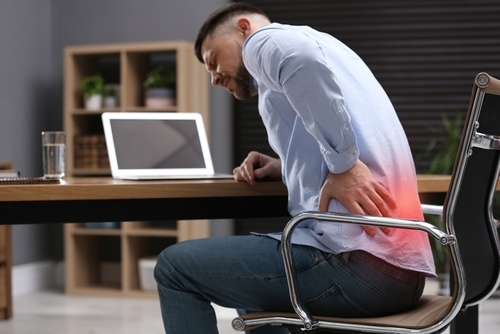You might have heard of herniated discs and the radiculopathy (referred nerve pain) they cause down the limbs.
But, is every nerve pain caused by a herniated disc?
And…
What the is the truth behind sciatica pain?
 Sciatica pain is a common yet misunderstood condition that affects up to 40% in people not only in the UK and London, but also all over the globe at least once in a lifetime. [1]
Sciatica pain is a common yet misunderstood condition that affects up to 40% in people not only in the UK and London, but also all over the globe at least once in a lifetime. [1]
To explain the relationship between herniated discs and sciatica, you need to know more about the sciatic nerve and where its pain comes from.
Meet the Sciatic Nerve
The sciatic nerve is the biggest nerve in your body.
Research shows that it originates from your back and travels down the back of your thigh providing motor supply to several muscles and sensory supply to you’re a big portion of your skin. [2]
When the sciatic nerve is pinched anywhere along its course, it causes symptoms down the leg in form of:
- Tingling
- Numbness
- Burning
- Heaviness
- Muscle weakness [2], [3]
But, what is the cause of nerve pinching?
Read on to answer this question and describe the impact of herniated discs on spinal nerves, emotional, mental health and physical health.
By the way,
If you would like to learn why my clients describe this unique back rehab transformation methodology as the most successful, predictable and comprehensive back transformation programme in the UK here are just a few case studies like Hayley, Franco, Elizabeth Tiffany, Jan, Michaela, W.T. Police officer, Emma, Huw or Dr Christian NHS.
And if you have some questions left unanswered, or you would like to talk to London’s number 1 personal trainer about your own sciatic pain and your back pain rehabilitation, request a FREE CONSULTATION NOW!
Causes of Herniated Discs Leading to Sciatica
 Research shows that sciatica pain can be caused by several conditions. [2],[4]
Research shows that sciatica pain can be caused by several conditions. [2],[4]
Even though the most common of sciatica is a herniated disc, there are also other causes that need to be considered in order to find the cause and determine the proper rehabilitation plan.
To make this easier, let’s think of the sciatic nerve as a long railway that starts at a station (the spinal nerves in your back) and travels through your back, buttock and down your leg. [2]
The nerve signal travelling through the sciatic nerve is more like trains travelling on this railway.
If this railway is interrupted, it could be at any level or any stations of these ones hindering the signals and affecting nerve function.
In other words, nerve pinching can occur at:
1- The spinal level
Which means the nerve is pinched at its spinal nerves root.
It could be by:
- Disc herniation or rupture
- Spinal stenosis
- Age-related spinal degeneration
- Spondylolisthesis. [1],[2],[5]
2- Non-spinal Level
Observing the MRI of patients with sciatica revealed that 9.6% of them had no disc disease.
Imagine how these statistics apply when it comes to people in the UK and London!
Although it’s less common, believe it or not, pinching can occur anywhere along the course due to:
- Muscle spasm; particularly of the piriformis muscle located deep in the buttock muscles.
- Injuries and accidents
- Post-operative complications,
- Gynecologic conditions in females such as Uterine fibroid, pelvic endometriosis
- Compression by growths like tumours or abscesses [1],[5],[6]
- Lifestyle factors such as Occupational hazards, poorly sitting down and body postures that put abnormal loads on the body.
- Sedentary lifestyle and Lack of Gym Exercise Customisations When You Train [7]
Don’t miss the chance to find out what is causing your sciatica and adopt a new lifestyle to get rid of your pain with London’s best rehab personal trainer.
Request a FREE CONSULTATION NOW!
Symptoms of Sciatica Resulting from Herniated Discs
 Not every leg pain is sciatica pain.
Not every leg pain is sciatica pain.
So, if you have a herniated disc, Lower back pain, difficulty in sitting or standing and pain referring down your leg [8], you need to learn more about how sciatica feels like.
Here are some unique characteristics of sciatica:
Only one leg!
Research shows that it is difficult to get sciatica pain in both legs, even if you have a broad central disc bulging into the spinal canal, it is not likely that it will cause the exact same pain on both sides. [1]
So, if you have pain in both legs, you need to dig deeper into the cause.
It’s neural!
Neural pain is distinguishable from other types of pain by being Excruciating Radiating pain that might also be described as Numbness and tingling. [9]
So, if your pain does not feel like that, for example, if your leg hurts when you touch, or when you move your knee, sciatica is not your thing.
Along the course
Sciatica pain must be felt along the course of the nerve. (i.e., buttocks, back of the thigh and leg and down the sole of the foot).
In other words, if your pain is in the knee or the hip, research shows that it is not caused by the sciatic nerve. [10]
And if your pain feels neural but it is in the front of the thigh or any other part of your leg other than the back, it might be caused by a different nerve.
It Involves Muscles
Because the sciatic nerve supplies motor signals to your muscles, a pinched sciatic nerve will cause leg muscle weakness.
This means you may notice overactive and underactive muscles in addition to recurrent cramps and spasm. [11]
Preventing Sciatica from Herniated Discs
 Because prevention is better than cure, here is how you can prevent sciatica, even if you already have a herniated disc:
Because prevention is better than cure, here is how you can prevent sciatica, even if you already have a herniated disc:
1- Stay Active
Having a regular exercise and stretching routine will help you keep your tissues of proper length and muscles of proper strength to prevent your herniated disc from worsening.
Research shows that when you succeed in preventing your disc from bulging more, you will eventually prevent nerve pinching and sciatica [12],[13] and this is where about Jazz comes in.
2- Watch Your Posture
Research shows that keeping a good posture and maintaining proper ergonomics at work and home help you avoid placing abnormal load on your spine and prevents worsening of your herniated disc. [14]
3- Don’t Gain Pounds
Every extra pound you carry around is an overload on your spine and joints plus fat is an inflammatory tissue and inflammation could aggravate your pain.
If you are overweight, try to shed the extra pounds and make sure you are maintaining a healthy body weight in order to improve your spine health. [1]
4- Don’t Squeeze Your Discs
Avoiding activities that strain the spine is an important part of preventing sciatica.
Always avoid awkwardly bending or twisting your spine and avoid carrying heavy weights.[1],[15]
Creating The Laser Sharp Exercise Customisations You Need and Your Effective Rehab Programme can be one click away from you!
Speak to Jazz Alessi and explore your options in a FREE CONSULTATION
CONCLUSION
Sciatica pain is a symptom that might be caused by several conditions including disc herniation.
For this reason, it is important to customise the rehabilitation programme according to the mechanism of nerve compression.
Imagine two friends complaining of sciatica, one of them has an MRI showing disc herniation compressing the spinal nerves root.
While the other has no disc herniation in the MRI but has severe muscle spasm and pain in the buttock.
When setting a rehabilitation programme, an expert rehab personal trainer in London like Jazz would recommend a customised core strengthening programme for the first one in order to improve spinal stability and nerve flossing to improve nerve mobility when inflammation subsides.
At the same time, the expert rehab personal trainer will recommend stretching programme to improve the flexibility of the back and hip muscles.
He might also recommend selected or customised Pilates and Yoga modifications to restore the overall flexibility as a part of their sciatica rehabilitation.
This is just an example of how every person with sciatica requires a laser-sharp customised disc rehabilitation programme that suits their own condition.
If you are in London.
You can also get yours.
CONSULT JAZZ ALESSI FOR FREE!Who is Jazz Alessi?
For Jazz, sciatica is a symptom that needs comprehensive assessment to set the right sciatica rehabilitation programme. He goes thoroughly goes through medical reports, assesses your mobility, flexibility, muscle strength and body composition to design a laser-sharp customised rehab programme that meets your very personal health goals using his extensive knowledge and experience in evidence-based back rehab exercise and nutrition.
FAQs
1. Can a herniated disc cause sciatica?
Yes, a herniated disc is considered the most common cause of sciatica.
2. How long does sciatica from a herniated disc last?
Sciatica pain and symptoms are caused by inflammation of the sciatic nerve due to compression. This inflammation often takes 4 – 6 weeks to subside. However, if you do not abstain from the habits that caused your disc problem, the condition may take longer or even worsen.
3. Can sciatica caused by a herniated disc be cured without surgery?
Although disc herniation is not reversable, its symptoms can be reduced and / or eliminated by proper weight management, selected exercises, lifestyle modification and following a laser sharp customised rehab programme to prevent recurrence.
4. How do I know if my sciatica is caused by a herniated disc?
The most accurate way to get an accurate diagnosis is to visit your injury rehab doctor who may recommend an MRI to see your intervertebral discs and perform physical checks to see if you have disc herniation.
5. How to achieve long term immediate relief for sciatica pain?
You can feel an immediate relief by taking a pain killer, applying hot packs or relaxing in a position that relieves your back pain. However, this is only temporary. Long term pain management does not occur overnight, you need to be patient and follow a rehabilitation plan to see long-term results.
6. How to get rid of sciatica pain permanently using a customised exercise rehab?
It depends on the cause of your sciatica. Generally speaking, in many cases you can permanently get rid of sciatica by following a customised back rehab programme that focuses on losing extra weight, improving core strength and spine stability, correcting your posture and restoring nerve mobility.
References
1- M. A. Stafford, P. Peng, D. A. Hill, Sciatica: a review of history, epidemiology, pathogenesis, and the role of epidural steroid injection in management, BJA: British Journal of Anaesthesia, Volume 99, Issue 4, October 2007, Pages 461–473, https://doi.org/10.1093/bja/aem238
2- Giuffre BA, Jeanmonod R. Anatomy, Sciatic Nerve. [Updated 2022 Jul 25]. In: StatPearls [Internet]. Treasure Island (FL): StatPearls Publishing; 2023 Jan-. Available from: https://www.ncbi.nlm.nih.gov/books/NBK482431
3- Trager, Robert. (2019). Symptoms of sciatica.
https://www.researchgate.net/publication/351351519_Symptoms_of_sciatica
4- Davis D, Maini K, Vasudevan A. Sciatica. [Updated 2022 May 6]. In: StatPearls [Internet]. Treasure Island (FL): StatPearls Publishing; 2023 Jan-. Available from: https://www.ncbi.nlm.nih.gov/books/NBK507908/
5- Trager, Robert. (2019). Chapter 3 The causes of sciatica.
http://www.researchgate.net/publication/357114761_Chapter_3_The_causes_of_sciatica
6- Shakeel, Muhammad & Kumaravel, Manickam & Mackenzie, James & Knight, David. (2009). An Uncommon Cause of Sciatica. Journal of the College of Physicians and Surgeons–Pakistan : JCPSP. 19. 127-9.
https://www.researchgate.net/publication/23998739_An_Uncommon_Cause_of_Sciatica
7- Suresh, M. & Mohanraj, K.G. & Balakrishnan, Nivethigaa. (2020). Association Between Sciatica, Obesity And Sedentary Lifestyle Among Population – A Survey. International Journal of Pharmaceutical Research. 12. 1965-1972. 10.31838/ijpr/2020.12.02.0263.
www.researchgate.net/publication/346359913_Association_Between_Sciatica_Obesity_And_Sedentary_Lifestyle_Among_Population_-_A_Survey
8- NHS- Leg pain linked to lower back (sciatica)
https://www.tims.nhs.uk/wp-content/uploads/2020/06/1.9-TIMS-Sciatica.pdf
9- Cavalli E, Mammana S, Nicoletti F, Bramanti P, Mazzon E. The neuropathic pain: An overview of the current treatment and future therapeutic approaches. Int J Immunopathol Pharmacol. 2019 Jan-Dec;33:2058738419838383. doi: 10.1177/2058738419838383. PMID: 30900486; PMCID: PMC6431761.
https://www.ncbi.nlm.nih.gov/pmc/articles/PMC6431761/
10- Allan H. Ropper, M.D., and Ross D. Zafonte – Sciatica
https://www.nejm.org/doi/pdf/10.1056/NEJMra1410151
11- NHS Sussex Community – Sciatica
https://www.sussexcommunity.nhs.uk/downloads/services/msk/sciatica.pdf
12- Adams, John & Inman, Verne. (1959). STRETCHING OF THE SCIATIC NERVE—A Means of Relieving Postoperative Pain Following Removal of Ruptured Lumbar Intervertebral Discs. California medicine. 91. 24-6.
https://www.researchgate.net/publication/9903342_STRETCHING_OF_THE_SCIATIC_NERVE-A_Means_of_Relieving_Postoperative_Pain_Following_Removal_of_Ruptured_Lumbar_Intervertebral_Discs
13- Alex Bennet – The Effect of Core Strengthening Exercises and Sciatic Nerve on Sciatica pain
https://opus.govst.edu/cgi/viewcontent.cgi?article=1109&context=capstones
14- Paolucci T, Attanasi C, Cecchini W, Marazzi A, Capobianco SV, Santilli V. Chronic low back pain and postural rehabilitation exercise: a literature review. J Pain Res. 2018 Dec 20;12:95-107. doi: 10.2147/JPR.S171729. PMID: 30588084; PMCID: PMC6305160.
https://www.ncbi.nlm.nih.gov/pmc/articles/PMC6305160/
15- Orthopedic Association of Hartford – Sciatica home exercise
https://oahct.com/wp-content/uploads/2020/04/OAH-SCIATICA-EXERCISES-R2.pdf



